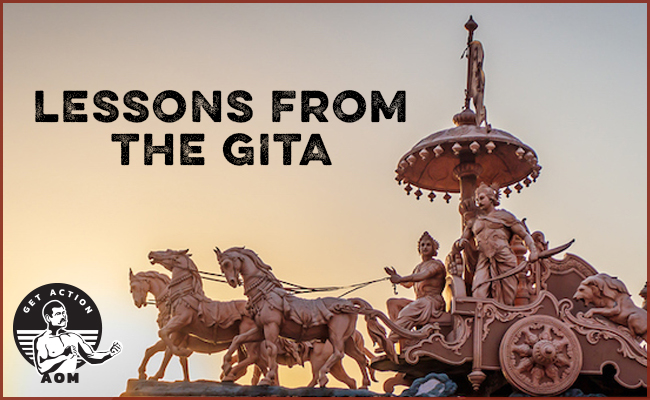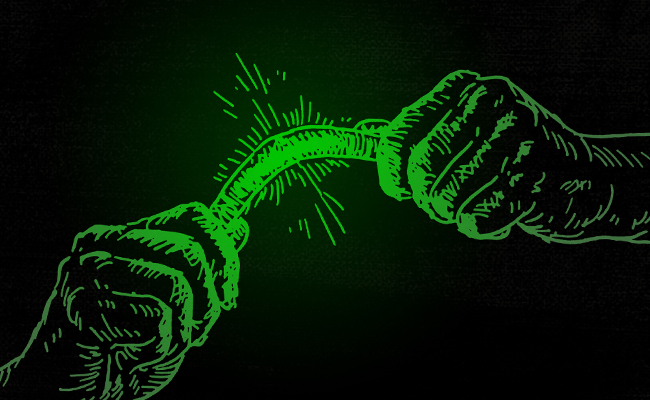
One of my favorite books is a two-thousand-year-old text of Hindu scripture called the Bhagavad Gita.
I’ve known about the Gita since I was in high school. For example, I knew that Robert Oppenheimer, the father of the atomic bomb, quoted the Gita when he saw the bomb tested for the first time: “I am become Death, the destroyer of worlds.”
And as I read the biographies of great men throughout my adult life, I noticed that many of them counted the Bhagavad Gita as one of their favorite books. Henry David Thoreau was a fan. In fact, this neck-bearded 19th-century New Englander called himself a yogi. Thoreau’s pal Ralph Waldo Emerson was also a student of the Gita, and you can find the book’s fingerprints all over the Transcendental movement those two guys helped kickstart.
Martin Luther King Jr. read the Gita, as did Tolstoy and Beethoven. Alduous Huxley was a student of the Gita too, and said this about it:
The Bhagavad-Gita is the most systematic statement of spiritual evolution of endowing value to mankind. It is one of the most clear and comprehensive summaries of perennial philosophy ever revealed; hence its enduring value is subject not only to India but to all of humanity.
Bestselling author and friend of the AoM podcast Steven Pressfield has written about how he reads the book every year and how it served as the inspiration for The Legend of Bagger Vance.
Despite seeing the Gita show up in so many notable men’s reading lists, until a few years ago, I had never read it myself.
Then I went to see a therapist who recommended that I check out a book called The Great Work of Your Life by Stephen Cope. I bought it on Kindle and started reading it that day.
Guess what that book was about?
The Bhagavad Gita.
I figured that life was telling me that I needed to finally read the Gita myself, so I bought a copy.
I read it in one day and highlighted the heck out of it. As I said, it’s become one of my favorite books. And like Pressfield, I’ve made it a habit to read it at least once a year to help scrub the barnacles off my psyche and give myself an existential kick in the pants.
There are a lot of life lessons packed in the Gita. As Huxley observed, it’s one of the world’s best summaries of universally-applicable principles of philosophy. A person doesn’t have to be a Hindu to appreciate it. Individuals of any religion, or no religion at all, can also find insights from the book because, at its core, the Gita is simply about how to take action in a world of uncertainty. It is, in other words, all about the most timeless and human of problems.
I highly recommend picking up a copy of the Gita yourself. You won’t regret it. But to whet your appetite, I highlight a few of the lessons that I’ve taken from the text over the years.
Life Is Filled With Paralyzing Tension
The Bhagavad Gita begins in the middle of an apocalyptic war between families. A young warrior named Arjuna, along with his charioteer, Krishna (a god in disguise), rides up to a battle that’s about to unfold.
Arjuna asks Krishna to stop. What he sees is unnerving: his own kin is gathered together to fight him. As a warrior, Arjuna is duty-bound to take part in the war, but it feels immoral to raise a sword against his family. He cries out to Krishna, “Conflicting sacred duties confound my reason!” He continues his lament:
My limbs sink,
My mouth is parched,
My body trembles,
The hair bristles on my flesh.
The magic bow slips
From my hand, my skin burns,
I cannot stand still,
My mind reels.
Arjuna sinks to the floor of his chariot, paralyzed by confusion as to what he should do.
Boy, I can relate. And I’m sure you can, too.
We all have moments where we just want to crumple into a ball because we feel pulled in two different directions. We don’t know the right choice to make, and feel paralzyed with confusion.
Should I take the better paying job, even though it will move us away from our extended family?
Should I blow the whistle on my employer, even though I risk my livelihood and reputation?
Should I continue to send my kid to school, even if he’s being bullied?
Should I leave my faith, even though I know it will disappoint my wife and parents?
Should I continue to try to have a relationship with my brother, even if his behavior is destructive and toxic?
We’d like the answers to life’s problems to be simple, cut and dry. But as I’ve gotten older, I’ve learned that a lot of life’s problems are wicked problems. These are problems where it’s hard to even grasp the nature of the problem, let alone the solution. They’re the kind of problems that make your limbs sink and your mind reel.
What the Gita has taught me is that wicked problems have always haunted humans. Hindus living thousands of years ago grappled with them. My pioneer ancestors living in the American West grappled with them. My grandparents living through an economic depression and world war grappled with them.
And for some reason, knowing that gives me comfort.
When you’re in the vortex of self-pity and anguish about your own endlessly sticky dilemma, it’s easy to think that you’re the only one who has ever gone through something like it. But the Gita shows you that you’re not.
One of the constants of the human condition is having to bump up against paralyzing tensions over and over again.
And if human beings living thousands of years ago could navigate these conflicts and collisions, then so can I.
Resolving the Tension Requires Knowing Your Dharma
After Arjuna slumps down in his chariot, Krishna starts giving him a divine pep-talk. “This despair and weakness in a time of crisis are mean and unworthy of you, Arjuna,” says Krishna. “Arise with a brave heart and destroy the enemy!”
But this isn’t enough to stir Arjuna. He continues being a mope.
“How can I, Krishna?” he asks.
Krishna then tells him the answer: Do your sacred duty!
In the yogic tradition, sacred duty is called dharma. In my interview with Stephen Cope, the author of The Great Work of Your Life, he described your dharma as your vocation or calling in life. It’s the thing that only you can do.
French philosopher René Guénon defined dharma as:
The essential nature of a being, comprising the sum of its particular qualities or characteristics, and determining, by virtue of the tendencies or dispositions it implies, the manner in which this being will conduct itself, either in a general way or in relation to each particular circumstance.
Kierkegaard would say your dharma is your True Self — the self that God wants you to be.
So, according to the Gita, the first step in overcoming the existential paralysis of life is to figure out what your dharma is. You have to know what you’re about.
Of course, that can be hard to discern.
Figuring out your dharma requires both thoughtful contemplation and concrete experimentation. You meditate. You act. You work through phases of trial and error. There is, unfortunately, no hack to the discovery of your life’s purpose.
But once you recognize your dharma, you begin to find clarity in the cacophony of human existence. It becomes a lodestar as you navigate life’s wicked problems.
Find your dharma and look to it constantly.
Your Dharma Doesn’t Have to Be Big
One of the mistakes that a lot of people make when figuring out their calling or dharma is that they think it has to be big. Like, go to the moon and discover a cure for cancer big. Or, as Steve Jobs would put it, “leave a dent in the universe” big.
But the Gita teaches us the opposite.
Your dharma is whatever it is life has called you to do, even if it’s small in scale, and no one but you knows about it.
It’s tempting to copy the dharma of great men in history so you can make a name for yourself. But as Krishna counsels Arjuna:
It is better to strive in one’s own dharma than to
succeed in the dharma of another. Nothing is ever
lost in following one’s own dharma, but competition
in another’s dharma breeds fear and insecurity.
Stephen Cope uses the career of Henry David Thoreau to bring home the idea that your dharma doesn’t have to be big. When Thoreau started his writing career, he wanted to be famous like his buddy Ralph Waldo Emerson. He wanted to be somebody and have his work read by the right people. So he moved to New York City to make it happen for himself.
But it didn’t happen. In fact, his effort to become a literary luminary resulted in failure and humiliation. He tried to write stuff that the smart set at the time would appreciate, but they weren’t having it. He faced rejection after rejection from publishers and journals.
Fellow authors flung personal insults at him. Nathaniel Hawthorne described Thoreau as being “ugly as sin, long-nosed, queer-mouthed, and with uncouth and rustic . . . manners.”
Ouch.
So after thirteen months of trying to make it in the Big Apple, Thoreau moved back to the far smaller town of Concord, Massachusetts. He then felt a call to head off to Walden Pond and build a shack so he could live more deliberately and write about the rhythms of nature. He found his dharma, and he put it into action.
His dharma wasn’t splashy. It wasn’t a big deal. At least at the time, it wasn’t.
Thoreau wrote about how much he spent on nails and how deep Walden Pond was. It was the stuff that stirred his soul. People laughed at him, but Thoreau didn’t care because he was doing what he felt called to do. When he published Walden, it met with a tepid reception. It took five years to sell 2,000 copies, and it went out of print after Thoreau’s death.
Decades after his death, Thoreau became a big deal. A real big deal. Walden is considered one of America’s greatest books and Thoreau one of its greatest philosophers.
But when Thoreau was sitting on pumpkins and writing about bugs, he didn’t know that would happen. He just cared about fulfilling his dharma — his calling to write about nature and man’s relation to it. Thoreau teaches us our dharma doesn’t have to be big and important to be meaningful. The most important thing is that it’s yours.
Look to your dharma and do it, be it ever so humble.
You Have a Right to the Labor, But Not to the Fruits
Sometimes the thing that keeps us from taking action in uncertainty — even when we know our dharma — is that we’re worried about how things will turn out. We want to know if our actions will lead to success or failure before we start. But we can rarely know how things will turn out, and if we wait to act until we’re able to see the end from the beginning, we’ll end up indefinitely stuck in a paralzyed purgatory.
Krishna counsels Arjuna on how to overcome this paralysis by analysis:
You have the right to work, but never to the
fruit of work. You should never engage in action
for the sake of reward, nor should you long for
inaction.…
Those who are motivated only by desire for the
fruits of action are miserable, for they are constantly
anxious about the results of what they do.
You have a right to the work, but never to the fruit of your work.
You have control over your actions, but not the outcomes.
It’s an insight that you see over and over again across time and cultures. You see it in Buddhism and Stoicism and even in the Christian concept of grace.
Embracing your right to the work while relinquishing your right to the fruit of it, means deeply investing in the action you take to fulfill your dharma, but not caring whether it turns out the way you hope. Taking action on your dharma is already a win!
Like all these ideas, this is a concept that’s easier to accept in the abstract than it is to implement in reality. Part of being human is grasping for the results. We want the A+, the acceptance letter to a prestigious university, the raise, the big house, the Instagram likes, the fame. It’s nice to have something to shoot for.
But the Gita teaches us one of life’s great paradoxes: the more you grasp for the results, the more they usually slip through your fingers. The more you try to create art that pleases others, the less brilliant, and ultimately pleasing, it becomes. The more you try to win, the more you psych yourself out of the victory. The more you seek happiness, the more it eludes you.
On the dharmic path, you do your best, relish the process, find your purpose in the action itself — and then let the chips fall where they may. You care, but don’t care.
While the above represent a few of the lessons I’ve taken from the Bhagavad Gita over the years, the text offers many more; you’ll also find insights about the nature of action and inaction, faith, and surrendering to something higher than yourself. If you’re looking for greater light on how to navigate life’s uncertainties and complexities, give it a read this year, and perhaps, every year thereafter.
For more insights from the Gita, check out our podcast with Stephen Cope:







